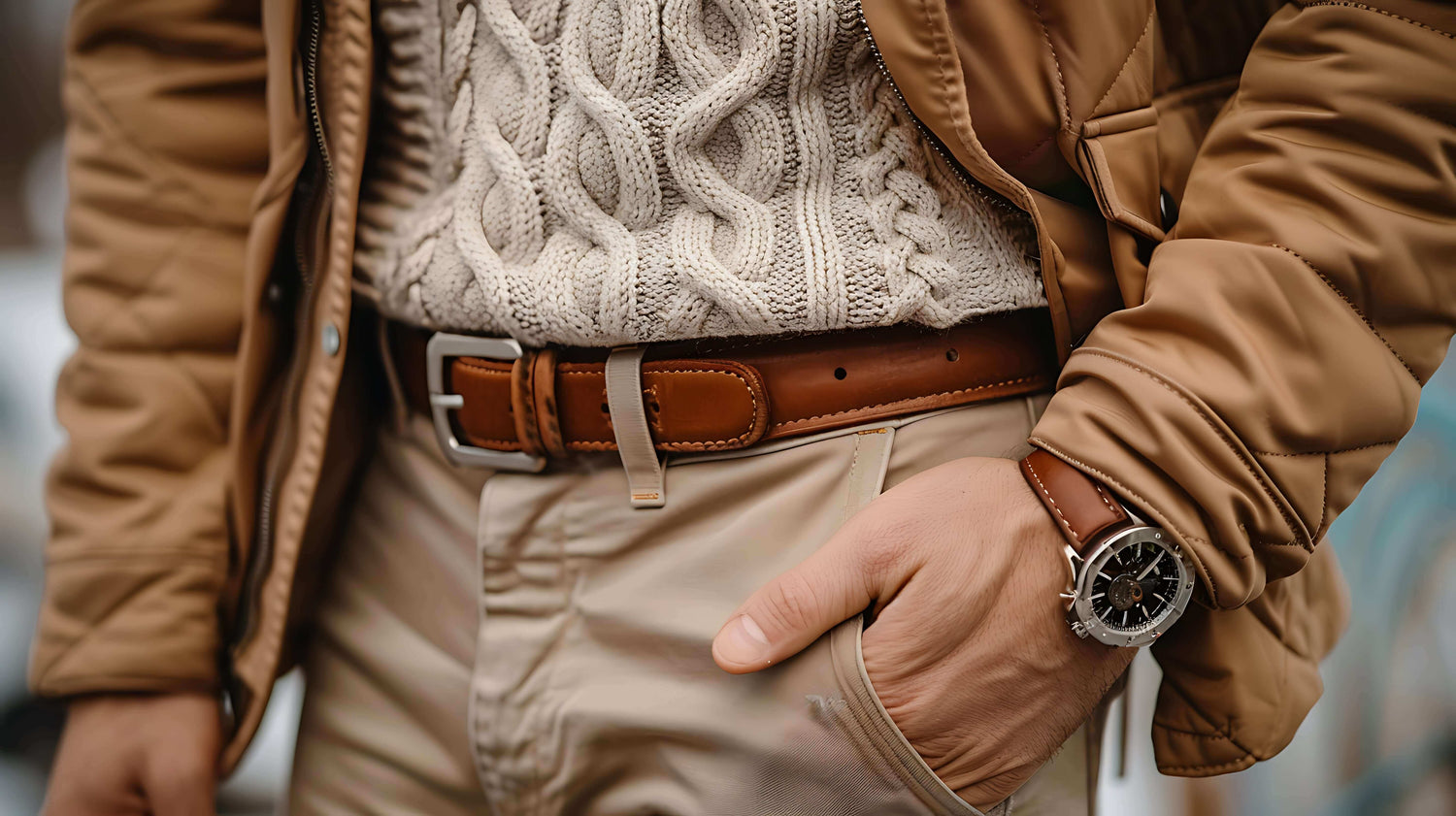Ein gerissener Ledergürtel muss nicht unbedingt weggeworfen werden. Je nach Pflege gibt es Möglichkeiten, einen gerissenen Ledergürtel wiederherzustellen . Durch den täglichen Gebrauch verlieren manche Gürtel an Glanz und Festigkeit. Mit etwas Glück können sie jedoch auf klassische Weise restauriert werden.
Unser Lieblingsgürtel wird so lange getragen, bis er Risse bekommt. Kann man rissiges Leder reparieren und wieder wie neu aussehen lassen? Ja, aber es hängt von der Art des Schadens und der Lederart ab. Bevor wir einen neuen Gürtel kaufen, klären wir, ob sich eine Reparatur lohnt.
Es gibt keinen irreparablen Riss im Gürtel. Mit der richtigen Pflege , Reinigung und Pflege können viele Gürtel wieder in ihren alten Glanz zurückversetzt werden. Hier ist die Ledergürtel-Restaurierung , und wir helfen Ihnen bei der Entscheidung, ob Sie ihn reparieren oder weggeben möchten.
Was führt dazu, dass Ledergürtel reißen?
Bevor wir über die Reparatur sprechen, sollten wir zunächst verstehen, warum der Schaden überhaupt entsteht. Leder ist ein natürliches Material und braucht wie Haut Pflege.
Zu den häufigsten Ursachen für Risse in Leder zählen:
-
Natürlicher Verschleiß im Laufe der Zeit.
-
Leder von geringer Qualität (wie gebundenes oder synthetisches Leder).
-
Trockenheit und Sonneneinstrahlung führen zu Feuchtigkeitsverlust.
-
Hohe Luftfeuchtigkeit kann zu Schimmel oder strukturellen Schwächen führen.
-
Übermäßige Wassereinwirkung ohne ordnungsgemäßes Trocknen.
- Mangelnde Lederpflege ist eine der Hauptursachen für Risse!
Kann ein gerissener Ledergürtel restauriert werden?
Ja, aber nur manchmal. Ob Ihr Gürtel restauriert werden kann, hängt von der Tiefe der Risse und der Art des verwendeten Leders ab .
Arten von Rissen:
-
Oberflächenrisse: Leichte Trockenheit oder feine Linien. Kann oft mit Lederpflegemittel für Gürtel behoben werden .
- Tiefe Risse oder Abblätterungen: Dies bedeutet normalerweise, dass die Struktur des Leders beschädigt ist.
Lederarten:
-
Vollnarbenleder oder Top-Grain-Leder: Langlebig und hochwertig. Das lohnt sich!
- Lederfaserstoff: Hergestellt aus zusammengeklebten Lederresten. Nicht zur Restaurierung geeignet.
Wann sich eine Restaurierung lohnt (und wann nicht)

Manchmal muss man loslassen. Und manchmal lässt sich der Lieblingsgürtel ganz einfach wieder zum Leben erwecken.
Restaurierungswürdig:
-
Kleinere Oberflächenrisse.
-
Gürtel werden aus Vollnarbenleder oder Top-Grain-Leder hergestellt.
-
Gürtel mit sentimentalem oder monetärem Wert.
- Gürtel, die noch immer solide Nähte und Struktur aufweisen.
Eine Wiederherstellung lohnt sich nicht:
-
Lederfaserstoff oder Gürtel mit extremer Abblätterung.
-
Riemen mit tiefen Strukturrissen oder gebrochenen Kanten.
- Günstige Gürtel, die weniger kosten als Restaurationsmaterialien.
So restaurieren Sie einen gerissenen Ledergürtel (Schritt für Schritt)
Bei der Lederrestaurierung geht es nicht nur darum, wahllos Pflegemittel aufzutragen. Folgen Sie dieser detaillierten Anleitung zur Ledergürtelreparatur, um professionelle Ergebnisse zu erzielen.
Schritt 1: Reinigen Sie den Riemen vorsichtig
-
Verwenden Sie ein weiches, feuchtes Tuch, um oberflächlichen Schmutz zu entfernen.
-
Mischen Sie ein wenig milde Seife oder einen speziellen Lederreiniger mit Wasser.
- Wischen Sie den Gürtel vorsichtig ab und lassen Sie ihn vollständig trocknen, bevor Sie etwas auftragen.
Schritt 2: Lederpflegemittel auftragen
-
Verwenden Sie ein hochwertiges Lederpflegemittel (muss Lanolin, Bienenwachs oder natürliche Öle enthalten).
-
Reiben Sie es mit einem weichen Tuch oder Ihren Fingern sanft in die Risse ein.
-
Lassen Sie es über Nacht einwirken .
- Dieser Schritt eignet sich gut zum Restaurieren alter Ledergürtel , da er sie weicher macht und ihnen ihre Flexibilität zurückgibt.
Schritt 3: Das Leder neu färben (optional)
-
Wenn der Gürtel verblasst ist, verwenden Sie Lederfarbe, um die gleichmäßige Farbe wiederherzustellen.
-
Wählen Sie eine Farbe, die zum Original passt.
-
Mit einem Schwamm oder einer kleinen Bürste auftragen und ausreichend trocknen lassen .
- Durch das Nachfärben eines Ledergürtels kann dieser fast wie neu aussehen.
Schritt 4: Versiegeln und schützen
-
Zum Abschluss verwenden Sie einen Lederbalsam oder ein Versiegelungsmittel , um die Feuchtigkeit einzuschließen.
- Dies schützt vor zukünftigen Rissen und Umweltschäden.
Bonus-Tipps: Verhindern Sie zukünftiges Cracken

Wenn Sie Ihren Ledergürtel jetzt pflegen, können Sie spätere Risse vermeiden. Befolgen Sie diese praktischen Tipps, damit Ihr Lieblingsaccessoire lange schön aussieht.
-
Regelmäßige Pflege hält Ihren Ledergürtel weich und rissfrei. Behandeln Sie ihn wie Ihre Haut und spenden Sie ihm häufig Feuchtigkeit.
-
Lagern Sie Gürtel flach oder locker gerollt, um tiefe Falten zu vermeiden und Risse im Leder durch Biegebeanspruchung zu verhindern.
-
Verwenden Sie alle paar Monate eine Lederpflege für Gürtel, um die Feuchtigkeit einzuschließen und Trockenheit zu verhindern.
-
Schützen Sie Ihren Gürtel vor direkter Hitze und Sonnenlicht. Trockenes Leder zu reparieren ist schwieriger, als es von vornherein zu vermeiden.
- Tragen Sie nach der Reinigung immer einen leichten Balsam oder ein Öl zur DIY-Lederrestauration auf , der einen langfristigen Schutz bietet.
Wenn es Zeit ist loszulassen
Manchmal ist ein gerissener Ledergürtel einfach nicht mehr zu retten, egal wie sehr man versucht, ihn zu restaurieren. Wenn er stark gerissen ist oder abblättert, ist es Zeit, mit der Reparatur aufzuhören und sich nach einem neuen umzusehen.
Worauf Sie bei einem neuen Gürtel achten sollten:
-
Vollnarbenleder (hält länger und altert wunderschön).
-
Robuste Nähte und solide Hardware.
-
Eine glatte, gleichmäßige Oberfläche ohne Klebespuren.
-
Etwas dickeres Leder für den täglichen Gebrauch.
- Wählen Sie eine seriöse Marke mit guten Bewertungen.
Abschließende Gedanken
Die Restaurierung eines Ledergürtels ist möglich, aber nur, wenn sich der Aufwand lohnt. Mit der richtigen Pflege und Ledergürtelpflege können Sie einen gerissenen Ledergürtel oft wiederherstellen . Kleinere Schäden? Versuchen Sie es mit einer DIY-Lederrestaurierung, bevor Sie ihn ersetzen.
Wenn er jedoch abblättert oder brüchig ist, lassen Sie ihn los. Prüfen Sie immer zuerst die Lederart. Mit wenig Aufwand sieht Ihr Gürtel wieder wie neu aus. Wissen Sie, wann Sie ihn reparieren und wann Sie ihn weglassen sollten. Ihr perfekter Gürtel verdient die richtige Pflege.
Populäre Artikel
- Gürtelholster vs. Paddelholster : Dieser Artikel vergleicht zwei Holsterdesigns zum verdeckten Tragen einer Schusswaffe.
- Die Namen der verschiedenen Teile eines Gürtels : Dieser Artikel erklärt die verschiedenen Teile eines Gürtels, wie die Schnalle, den Riemen und die Schlaufe.
- So stanzen Sie ein neues Loch in einen Ledergürtel : Dieser Artikel enthält Anweisungen zum korrekten Stanzen eines neuen Lochs in einen Ledergürtel. Es gibt zwei Links zum selben Artikel.
- Slide-Gürtel vs. Einsatzgürtel : Dieser Artikel vergleicht zwei Gürteltypen: Slide-Gürtel (die keine Löcher haben und eine größenverstellbare Schnalle verwenden) und Einsatzgürtel (die einen Gurt aus Gewebe und eine Schnalle mit Verriegelungsmechanismus haben).
- Betonen Sie Ihren Stil mit Strassgürteln : In diesem Artikel erfahren Sie, wie Sie Strassgürtel tragen und in Ihr Outfit integrieren.
- Wie man Löcher in den Gürtel macht, ohne ihn zu beschädigen : Dieser Artikel gibt Tipps, wie man Löcher in den Gürtel macht, ohne ihn zu beschädigen. Es scheint einige Überschneidungen mit dem dritten Artikel zu geben.
- Taktische Gürtel für Frauen : Dieser Artikel befasst sich mit taktischen Gürteln für Frauen, die Stil und Funktionalität vereinen.
- Strassgürtel zum Selbermachen : Dieser Artikel bietet eine Anleitung zum Erstellen Ihres eigenen Strassgürtels.


